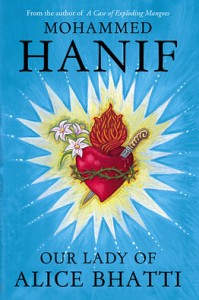Nearly every other review of this book Our Lady of Alice Bhatti compares this book with the first book of the author ‘A Case of Exploding Mangoes’. And ends up talking about his critically acclaimed first book more than this book. I have not read the first book. So I guess this may be one of the few independent reviews of this book.
Reading this book is like watching a slideshow. When the scene moves from one place to another, from one character to another. Some scenes are connected, some seem disjointed. But there is a gap between all the scenes that are left for the reader to fill using his or her own imagination. The plot is based in Karachi in Pakistan. But it could have been anywhere in the country. The backdrop really does not play many roles in the story. Nor is the time mentioned explicitly, so it could be anytime in Pakistan’s history. Unless you can estimate the time through the making of the weapons used. The absence of mobile phones or even telephones can push the story back by few decades. It is like the author is saying time is immaterial.
The Central character of the story is Alice Bhatti, a Junior Nurse in a welfare hospital called Sacred. She is a Christian from the sweeper community whose father is a well-known choohra or sweeper. They live in French Colony. A colony where people like them live, away from the other communities. She has lived in Jail for a charge of attempt to murder. And is employed by the Sacred after the jail term – why without any hassles is the gap for you to fill. In the peak of the story, she falls in love with another weird character – a bodybuilder who works for the police. And does their odd jobs that they do not want to do themselves.
The love story is strange, as they meet only a couple of times in the hospital. And then they are married on a nuclear submarine for no rhyme and reason. And they try and live in his house, going through the strangeness faced by most couples when they start living together for the first time. She goes through his absence from their home only to die when he next presents himself. There are side characters of a young boy who is nursing his dying mother with all possible devotion. A senior nurse who lives with a disguised identity but shows her heart when she is touched. There are doctors who have their own whims and fancies, as are the police inspectors. There is an on-the-run convict who changes the course of life for main characters.
The author of Our Lady of Alice Bhatti tries to showcase the society as it exists in his times. And people on fringes always make an interesting story. He brings out the casteism that exists in the society. The treatment of women and their image in the minds of men – they want to rape every woman around them. But when it comes to their mothers they are full of devotion. It shows the state of hospitals and the strange relationship between the staff and the patients. Where sometimes patients can be killed by pulling out some vital equipment. But will be offered the last prayers by the same staff. Where staff can wish one patient be dead so that they can offer the bed to another. Where a doctor will refuse to stitch after surgery till his fees have been paid in full.
Personal lives of most of the characters cannot be called normal. Most of them have a strained and detached relationship with their families. And this is again a glimpse of the society. An act of mystery and mysticism that have been used to close the story also tell that when everything else fails, people turn to Gods, spirits, supernatural powers and Avatars of Gods on earth.
A dry read but I am not sure if there are many works that touch these subjects in a country we only know through skewed media reports. So read Our Lady of Alice Bhatti to know how people on the fringes live in Pakistan.
You may buy this book – Our Lady of Alice Bhatti by Mohammed Hanif at Amazon.









